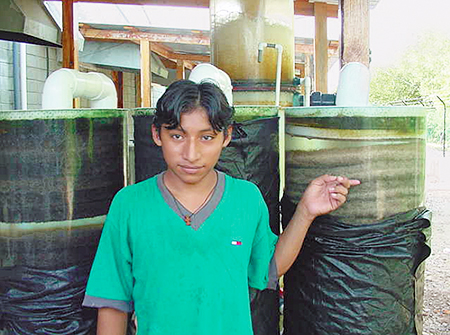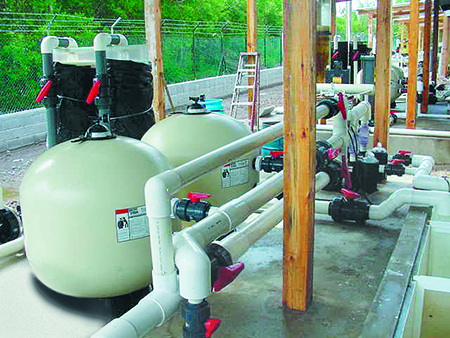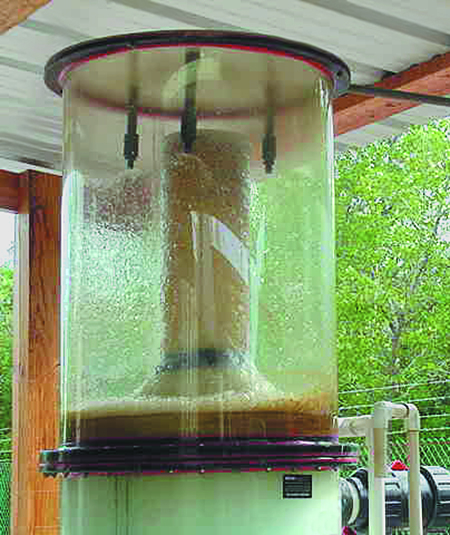Recirculation technology aids water quality, increases biosecurity, minimizes environmental impacts

GML, a shrimp hatchery of the Grupo Granjas Marinas (Seafarm International) group, uses a water recirculation system for the production of Litopenaeus vannamei postlarvae in Honduras. Although three labs in the country have maturation units, only GML has achieved consistent production with recirculation.
The hatchery produces a monthly average of 450 million shrimp nauplii and about 90 million postlarvae. Its maturation facility was designed to provide sufficient water of adequate quality for broodstock maturation, and to significantly reduce wastewater discharges into nearby estuaries.
System steps
The GML system has five steps for water treatment and quality improvement: coarse solids removal, fine solid removal, aeration, biofiltration, and disinfection. GML’s facility consists of five maturation units, each with 12 tanks. Three units use biodisc substrates, and the other two have independent, fluidized sand bed filters.
Solids and waste removal
Water goes to a sump or collection box, where it is filtered to remove excess feed, molts, feces and other debris. This drain is divided in three sections, where sedimentation and filtration are performed through 200- and 100-μ mesh. After this, water is pumped through two 10-μ rapid sand filters. These units require constant cleaning and monitoring, and well-trained people to operate them.
Fine solid removal

Suspended solids increase oxygen demand and can comprise 50 percent of total suspended solids. Organic solids also contribute to oxygen demand in the recirculation system. Protein fractionators are a practical way to remove these particles.
In this fractionation, air is supplied through a Venturi nozzle, which injects low-pressure air in a fiberglass cylinder and creates protein-rich foam. This foam in the upper part of the cylinder attracts small particles in its periphery, where they are grouped and washed out with sprinklers and drained. This discharge represents about 2 percent of the system’s water discharge.
Aeration
The GML systems require up to 4.5 milligrams per liter of oxygen to remove ammonia in water. The nitrification reaction oxidizes ammonia to nitrites and then to nitrates. To supply enough oxygen to the system, GML uses air stones in the drain, Venturis in the protein skimmer, and columns packed with bioballs after the fluidized sand beds to help remove carbon dioxide.
Biological filtration
Biofiltration, the basis of recirculation, removes ammonia nitrogen from water. For biofiltration to be efficient, proper culture enrichment, a suitable surface of adhesion and control of physical-chemical parameters are required.
‘Maturation’
Biodiscs and fluidized sand are used in GML’s biofiltration systems. Discs are “matured” one month before they are to be placed in the recirculating system. At first, biofilm development is almost imperceptible, but eventually the color turns from beige to brown-orange, and finally dark brown.
Mature discs smells like wet earth, while excessively aged or contaminated discs smell like acid. The film in development can also be checked for live organisms using a microscope. The presence of filamentous bacteria indicates development under low oxygen concentrations.
Fluidized sand takes longer to mature than biodiscs – up to 45 days in tests at GML. Systems with fluidized sand must be closely monitored, because a power failure can cause precipitation of the sand and reduction of nitrifying bacteria. This method is very efficient, but requires strict maintenance.
Water quality
The most important physical-chemical parameter is pH, which must be slightly basic (7.5 to 8.5) for optimum bacteria development. Temperature range for best growth is 20 to 30 degrees-C. Temperatures higher than 35 degrees-C threaten bacteria development and cause their activity to decline.
Bacteria have a wide range of salinity tolerance. However, inside a reactor, the more constant the salinity is, the more stable the bacterial population will be. These bacteria are very sensitive to ultraviolet light, and even indoors, red light is recommended.
Water disinfection
Disinfection follows biological filtration, and is an important process to maintain the health of animals. GML uses ultraviolet equipment with a guaranteed maximum flow of 150 gpm. This volume allows the facilities to recirculate up to 1,000 percent of the total volume of water daily. To monitor for harmful bacteria (Vibrio sp.), a microbiology department collects and analyzes samples biweekly at critical points in the water system.
Benefits of recirculation

As reflected in the performance of the GML system, recirculation promotes stable water quality, and retains nutrients and pheromones produced by females during courtship. It reduces dependency on external water sources and, with water exchange rates of 3 to 5 percent, increases biosecurity by preventing pathogens from coming into the system.
Recirculating systems typically promote better gonad development in both sexes and produce more consistent nauplii than flow-through systems. Recirculation technology is also environmentally friendly. It improves energy efficiency by helping maintain desired water temperatures.
Drawbacks
Recirculating systems need constant monitoring by trained personnel, with frequent testing of water quality, controlled pressure in pipelines, and backwashing of sand filters. These practices are common in maturation facilities, but in the case of recirculating systems, more detailed and intense labor is needed. GML employs around-the-clock maintenance crews for all electrical equipment like pumps and blowers. Sudden changes to feeding regimes in recirculating systems are not recommended, because there will not be enough capacity for digestion of the ammonia produced.
Conclusion
In maturation/broodstock holding facilities, recirculation technology promotes and maintains water quality, increases biosecurity, and minimizes effects on the environment. When implemented properly by trained personnel, they are more efficient than flow-through systems.
(Editor’s Note: This article was originally published in the June 2002 print edition of the Global Aquaculture Advocate.)
Now that you've finished reading the article ...
… we hope you’ll consider supporting our mission to document the evolution of the global aquaculture industry and share our vast network of contributors’ expansive knowledge every week.
By becoming a Global Seafood Alliance member, you’re ensuring that all of the pre-competitive work we do through member benefits, resources and events can continue. Individual membership costs just $50 a year. GSA individual and corporate members receive complimentary access to a series of GOAL virtual events beginning in April. Join now.
Not a GSA member? Join us.
Author
-
Jorge Quintana, MBA, MB
Granjas Marinas Larvicultura
Grupo Granjas Marinas
Choluteca, Honduras
Tagged With
Related Posts

Responsibility
Haiti’s hatchery of hope
Built on a dream of feeding some of the world’s poorest and most vulnerable people, a charity-built tilapia hatchery in Haiti now learns to stand on its own.

Health & Welfare
Latin America FAO project establishes hatchery standards, info system
At a United Nations Food and Agriculture Organization (FAO) workshop 14 shrimp-producing countries discussed strategies for controlling shrimp diseases.

Intelligence
Quality control measures improve tilapia production chain in Latin America
The experiences of tilapia farmers combined with effective quality control programs implemented by government have improved production in Mexico, Colombia, Ecuador, Peru and other Latin American countries.

Health & Welfare
Stirling researcher preps eyestalk-ablation alternative trials
University of Stirling Ph.D. student Simão Zacarias, who is from is Beira, Mozambique, will soon travel to Isla del Tigre, Honduras, to document evidence showing the benefits of breeding shrimp without eyestalk ablation. His is a journey of hopeful discovery.


